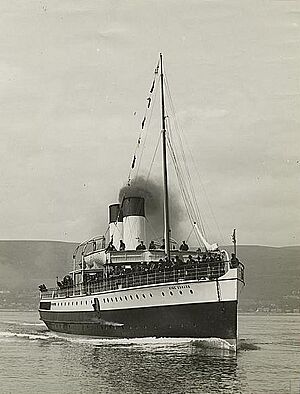William Denny and Brothers facts for kids
 |
|
| Private | |
| Industry | Shipbuilding |
| Fate | Liquidation |
| Founded | 1840 |
| Defunct | 1963 |
| Headquarters | Dumbarton, UK |
William Denny and Brothers Limited, often called Denny, was a famous Scottish company that built ships. They were known for creating many different types of vessels, from small sloops to large ocean liners and even early hovercraft.
Contents
History of Denny Shipbuilders
The Denny family started building ships a long time ago. The first known ship, a sailing sloop called Alpha, was built in Dumbarton in 1811 by William Denny (born 1779).
By 1823, the company was known as William Denny & Son. Their first ship under this name was a paddle steamer called Superb. Later, in 1845, the company changed its name to Denny Brothers. This included William Junior, Alexander, and Peter. In 1849, it became William Denny & Brothers, with William, James, and Peter Denny.
The Denny shipyard was located near where the River Clyde and the River Leven meet. The founder also owned and operated ships. He had interests in companies like the British & Burmese Steam Navigation Company.
Innovations in Ship Design
Denny built all kinds of ships. They were especially known for making excellent cross-channel steamships and ferries. They were pioneers in developing the ship's stabiliser. This device helps keep a ship steady in rough seas. They worked with Brown Brothers & Company from Edinburgh on this.
In 1913, their Channel steamer Paris was one of the first ships to use special geared turbine engines. These engines used new Michell tilting-pad fluid bearings. Denny also experimented with hovercraft and helicopter-like aircraft.
Denny & Co. Marine Engineering
A separate company for marine engineering was started in Dumbarton in 1850. It was called Tulloch & Denny. Peter Denny was one of its founders. In 1862, it became Denny & Co.. This company made many different types of marine engines. In 1918, it joined with William Denny & Brothers.
Dennys were always trying new things. They were one of the first shipyards in the world to have their own special testing tank. This tank is now a museum that you can visit. William Denny & Company closed down in 1963.
Denny Ship Model Experiment Tank
Inspired by the work of a famous ship designer named William Froude, Denny's built the world's first commercial ship testing tank in 1883. This amazing facility was used to test small models of ships. They explored different ways to make ships move, like propellers, paddles, and vane wheels.
Experiments were also done on models of the Denny-Brown stabiliser and the Denny hovercraft. This helped them see if these ideas would work in real life. Other companies also used the tank for their research. For example, Belfast-based Harland and Wolff tested a model of the liner Canberra here. They decided to add a special "bulbous bow" to the ship after successful tests at the Denny Tank.
After the Denny shipyard closed, the testing tank was used by Vickers Shipbuilding and Engineering Limited. They used it to test submarines until the early 1980s.
The tank reopened in 1982 as part of the Scottish Maritime Museum. It still has many of its original parts, including the 100-meter-long testing tank. The machine that pulls the models is still working and is sometimes shown to visitors. However, the tank is no longer used for new research.
Famous Ships Built by Denny
Denny built many important and interesting ships. Here are some of them:
- SS Margery (1814): This was the first steamship on England's east coast. It was also the first to sail on the River Thames and the first to cross the English Channel.
- SS Greenock (1815): This was the first steamship in Belfast and the first on the River Mersey.
- Cutty Sark (1869): A famous tea clipper. Denny's finished building it after the original builders closed down. You can see it preserved in London today.
- SS Coya (1892): A steamer built for Lake Titicaca in South America. It is now a floating restaurant.
- SS Sir Walter Scott (1899): An excursion steamer that still sails on Loch Katrine, Scotland.
- TS King Edward (1901): An excursion steamer and the first commercial ship ever powered by steam turbines.
- SS Parthia (1870): An ocean liner built for the Cunard Line. It had many different jobs and owners for over 80 years.
- SS Seaford (1893): A cross-channel ferry that sank in 1895 after hitting another ship.
- SS Sussex (1896): Another cross-channel ferry, built almost exactly like the Seaford. It was badly damaged by a German U-boat torpedo in 1916, and at least 50 people died.
- SS Brighton (1903): A cross-channel ferry that crashed into a large sailing ship called Preußen and was completely lost.
- SS Otaki (1908): A refrigerated cargo liner. It was the first commercial ship to use a mix of steam engines and a low-pressure steam turbine.
- HMS Engadine (1911): A cross-channel boat that was turned into a seaplane carrier in 1914. It was sunk by a mine in 1941.
- Delta King (1924–26): This ship is now a hotel, theater, and restaurant in California, USA.
- Delta Queen (1924–26): This ship is now a hotel in Tennessee, USA.
- TS Queen Mary (1933): A Clyde turbine steamer that was once a floating restaurant in London. It is now being restored in Glasgow.
- PS Caledonia (1934): A Clyde paddle steamer that became a minesweeper in 1939. It was later a pub and restaurant but was destroyed by fire in 1980.
- PS Ryde (1937): Built for the Southern Railway. It was the last coal-fired paddle steamer when it stopped service in 1969. It is now being preserved on the Isle of Wight.
- MV The Second Snark (1938): A former tugboat and tender that belonged to Denny.
- MV Lymington (1938): An Isle of Wight ferry that later became the Clyde ferry MV Sound of Sanda in 1974.
- MV Royal Iris (1950): A former Mersey ferry now docked in London.
- MV Fenerbahçe (1953): A former passenger ferry, now a museum ship in Istanbul, Turkey.
- HMS Jaguar (1957): A frigate that is now called BNS Ali Haider in the Bangladesh Navy.
- Denny D2 Hoverbus: An early attempt to build a hovercraft for passengers.
- GMV Aramoana (1961): This was the very last ship built by William Denny and Brothers. It was a Roll-on/roll-off Road/Rail ferry for New Zealand Railways Department.
Company Flag
The company's flag had a blue elephant on a white background. This image came from the official symbols of Dumbarton. It also showed how strong and solid the company's ships were.
See also


